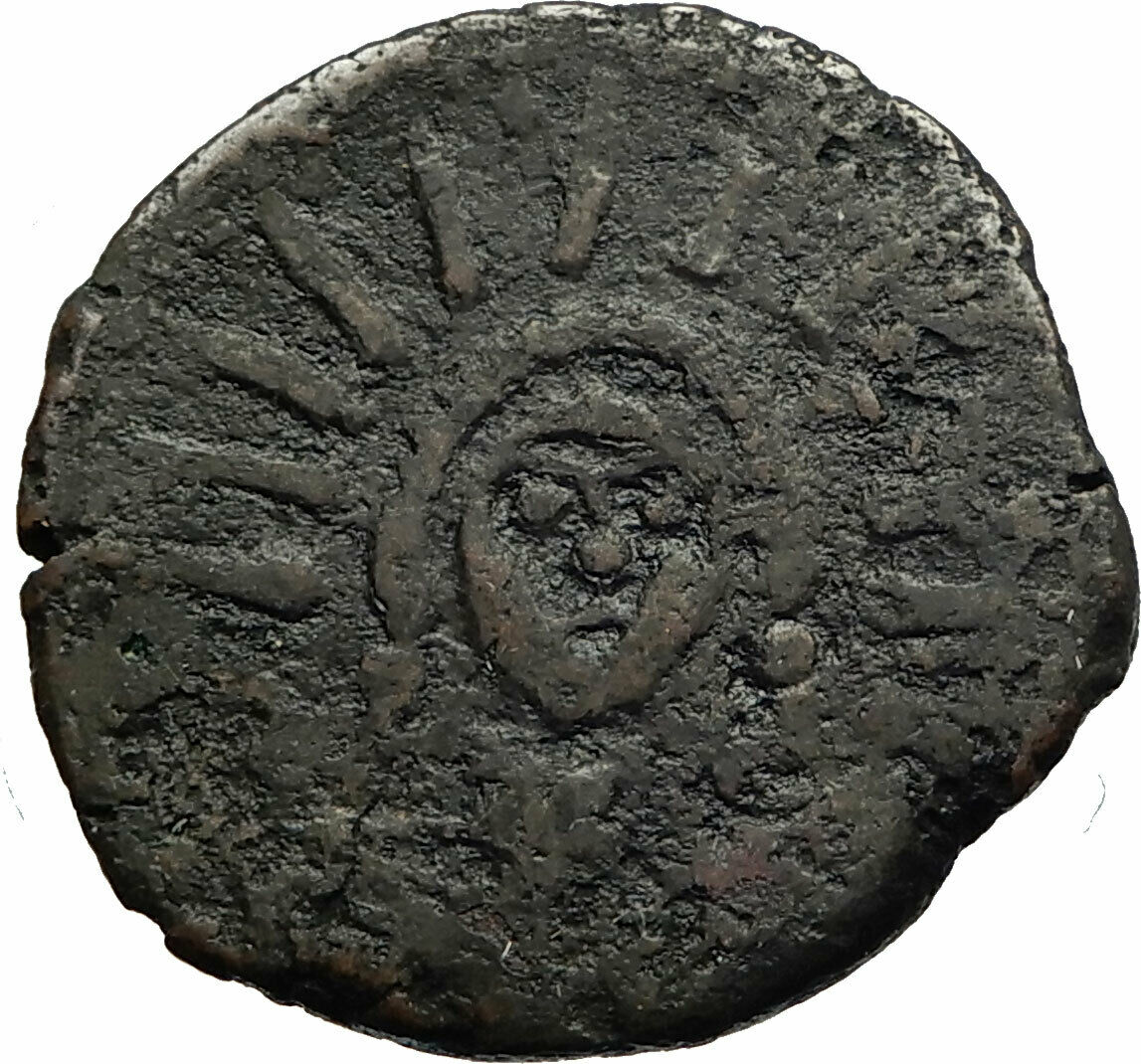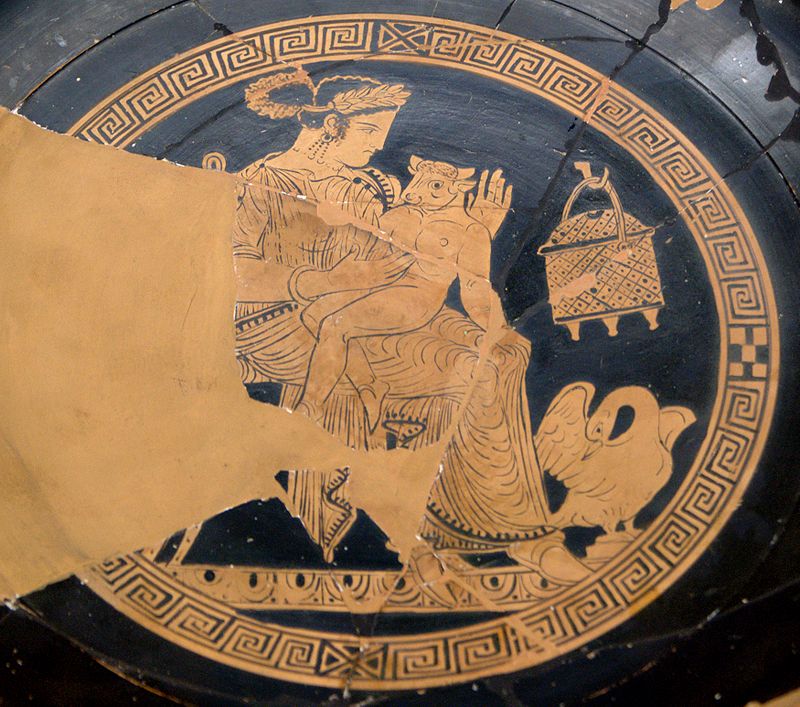Ancient Psychedelia: Alien Gods & Mushroom Goddesses
Online Book - Chapter 11, Page 197
Back to Online Book Mainpage / Next Page (Chapter 11, Page 198)
 (50a) Malaca in Spain, Helios c. 225 BC In this next Homeric Hymn, he is referred to as the “far-shining one” who is requested to bestow upon the Muse, “substance that cheers the heart”: “And now, O Muse Calliope, daughter of Zeus, begin to sing of glowing Helios whom mild-eyed Euryphaessa, the far-shining one, bare to the Son of Earth and starry Heaven. For Hyperion wedded glorious Euryphaessa, his own sister, who bare him lovely children, rosy-armed Eos and rich-tressed Selene and tireless Helios who is like the deathless gods. As he rides in his chariot, he shines upon men and deathless gods, and piercingly he gazes with his eyes from his golden helmet. Bright rays beam dazzlingly from him, and his bright locks streaming form the temples of his head gracefully enclose his far-seen face: a rich, fine-spun garment glows upon his body and flutters in the wind: and stallions carry him. Then, when he has stayed his golden-yoked chariot and horses, he rests there upon the highest point of heaven, until he marvellously drives them down again through heaven to Ocean. Hail to you, lord! Freely bestow on me substance that cheers the heart.” (138) Diodorus Siculus of Sicily reported that the Chaldeans called Cronus (Saturn) by the name Helios. Add this to the fact that I have not found any relation of Helios being a “healing divinity.” The move away from the healing aspect was yet another attempt to strip away what would be considered as medicinal and matriarchal values in the goddesses and gods. (139) Pasiphae was the daughter of the Greek deity Helios and married to King Minos. Her siblings are Aeetes and Kirke (Circe). (140) Pasiphae was tricked by Poseidon into making love to a bull as punishment or revenge for King Minos failing to sacrifice the bull that he brought up from the depths. This would make Pasiphae a cow, essentially who gave birth to a bull, the Minotaur. On a Greek kylix (wine cup) from the 4th century BC, Pasiphae is featured nursing the minotaur in her lap like all the sons nursed by the mother in her lap, which is a common theme on ancient figurines (42j). She was skilled in the use of herbs and drugs (pharmakopiaea) and she was an oracular goddess at Thalamae in Laconia where suppliants would sleep in her temples awaiting divine guidance in the forms of dreams. (141) |
 (42j) Pasiphae Nursing the Minotaur Italian Red Figure Shape Kylix c. 340-320 BC In the Minoan story of King Minos, the Bull and Cow play a very important role: “Asterius dying childless, Minos wished to reign over Crete, but his claim was opposed. So, he alleged that he had received the kingdom from the gods, and in proof of it he said that whatever he prayed for would be done. And in sacrificing to Poseidon he prayed that a bull might appear from the depths, promising to sacrifice it when it appeared. Poseidon did send him up a fine bull, and Minos obtained the kingdom, but he sent the bull to the herds and sacrificed another. “But angry at him for not sacrificing the bull, Poseidon made the animal savage, and contrived that Pasiphae (his wife) should conceive a passion for it. In her love for the bull she found an accomplice in Daedalus, an architect, who had been banished from Athens for murder. He constructed a wooden cow on wheels, took it, hollowed it out in the inside, sewed it up in the hide of a cow which he had skinned, and set it in the meadow in which the bull used to graze. Then he introduced Pasiphae into it; and the bull came and coupled with it, as if it were a real cow. And she gave birth to Asterius, who was called the Minotaur. He had the face of a bull, but the rest of him was human; and Minos, in compliance with certain oracles, shut him up and guarded him in the Labyrinth.” (142) When consulting an oracle, particular methods were prescribed, according to Pausanius: “Coming at eventide, the inquirer of the god, having burnt incense upon the hearth, filled the lamps with oil and lighted them, puts on the altar on the right of the image a local coin, called a “copper,” and asks in the ear of the god the particular question he wishes to put to him. After that he stops his ears and leaves the marketplace. On coming outside, he takes his hands from his ears, and whatever utterance he hears he considers oracular.” (143) (138) Homeric Hymn 31 (139) Healing Gods, p. 246 (140) Apollon. Rhod. iii. 999, &c.; Apollod. i. 9. § 1, iii. 1. § 2; Ov. Met. xv. 501; Cic. De Nat. Deor. iii. 19; Paus. v. 25. § 9 (141) Plut. Agis, 9; Cic. De Dir. i. 43; https://www.theoi.com/Titan/Pasiphae.html (142) Apollodorus, The Library, 3.13-3.14 (143) Healing Gods, p. 332; Pausanius 7.22.3 |
Go Back to Page 196